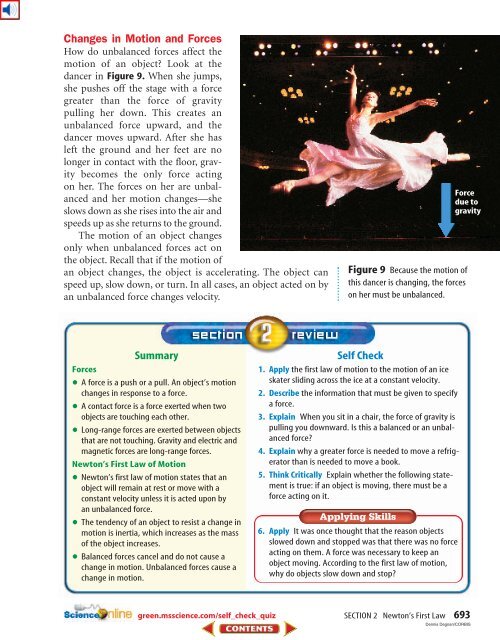Chapter 23: Newton's Laws of Motion
Chapter 23: Newton's Laws of Motion
Chapter 23: Newton's Laws of Motion
Create successful ePaper yourself
Turn your PDF publications into a flip-book with our unique Google optimized e-Paper software.
Changes in <strong>Motion</strong> and Forces<br />
How do unbalanced forces affect the<br />
motion <strong>of</strong> an object? Look at the<br />
dancer in Figure 9. When she jumps,<br />
she pushes <strong>of</strong>f the stage with a force<br />
greater than the force <strong>of</strong> gravity<br />
pulling her down. This creates an<br />
unbalanced force upward, and the<br />
dancer moves upward. After she has<br />
left the ground and her feet are no<br />
longer in contact with the floor, gravity<br />
becomes the only force acting<br />
on her. The forces on her are unbalanced<br />
and her motion changes—she<br />
slows down as she rises into the air and<br />
speeds up as she returns to the ground.<br />
The motion <strong>of</strong> an object changes<br />
only when unbalanced forces act on<br />
the object. Recall that if the motion <strong>of</strong><br />
an object changes, the object is accelerating. The object can<br />
speed up, slow down, or turn. In all cases, an object acted on by<br />
an unbalanced force changes velocity.<br />
Summary<br />
Forces<br />
• A force is a push or a pull. An object’s motion<br />
•<br />
changes in response to a force.<br />
A contact force is a force exerted when two<br />
•<br />
objects are touching each other.<br />
Long-range forces are exerted between objects<br />
that are not touching. Gravity and electric and<br />
magnetic forces are long-range forces.<br />
•Newton’s First Law <strong>of</strong> <strong>Motion</strong><br />
Newton’s first law <strong>of</strong> motion states that an<br />
object will remain at rest or move with a<br />
constant velocity unless it is acted upon by<br />
•<br />
an unbalanced force.<br />
The tendency <strong>of</strong> an object to resist a change in<br />
motion is inertia, which increases as the mass<br />
•<br />
<strong>of</strong> the object increases.<br />
Balanced forces cancel and do not cause a<br />
change in motion. Unbalanced forces cause a<br />
change in motion.<br />
green.msscience.com/self_check_quiz<br />
Figure 9 Because the motion <strong>of</strong><br />
this dancer is changing, the forces<br />
on her must be unbalanced.<br />
Self Check<br />
1. Apply the first law <strong>of</strong> motion to the motion <strong>of</strong> an ice<br />
skater sliding across the ice at a constant velocity.<br />
2. Describe the information that must be given to specify<br />
a force.<br />
3. Explain When you sit in a chair, the force <strong>of</strong> gravity is<br />
pulling you downward. Is this a balanced or an unbalanced<br />
force?<br />
4. Explain why a greater force is needed to move a refrigerator<br />
than is needed to move a book.<br />
5. Think Critically Explain whether the following statement<br />
is true: if an object is moving, there must be a<br />
force acting on it.<br />
6. Apply It was once thought that the reason objects<br />
slowed down and stopped was that there was no force<br />
acting on them. A force was necessary to keep an<br />
object moving. According to the first law <strong>of</strong> motion,<br />
why do objects slow down and stop?<br />
Force<br />
due to<br />
gravity<br />
SECTION 2 Newton’s First Law 693<br />
Dennis Degnan/CORBIS

















